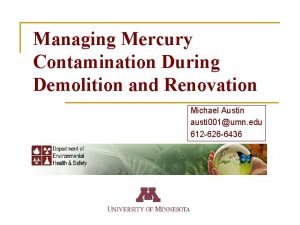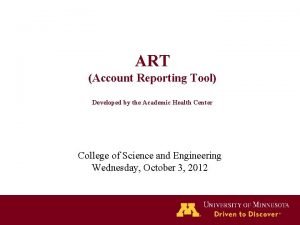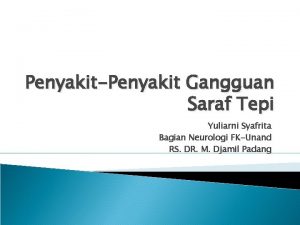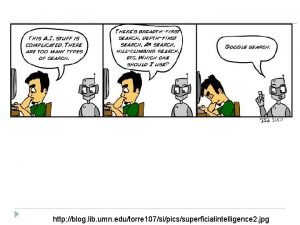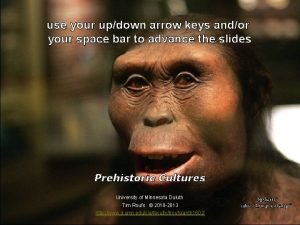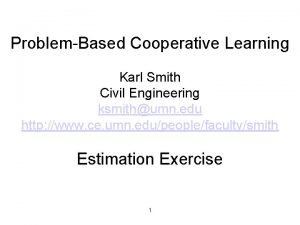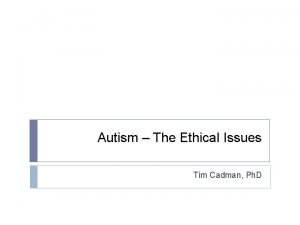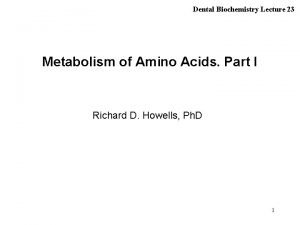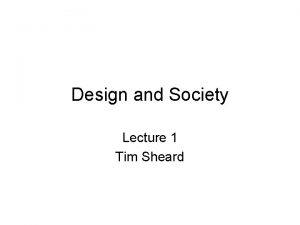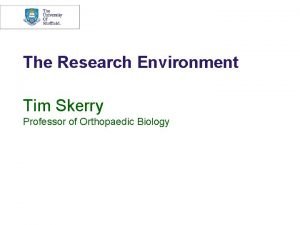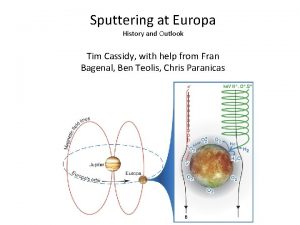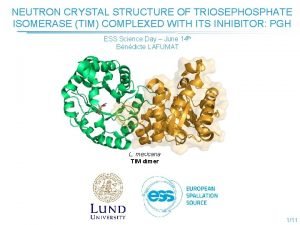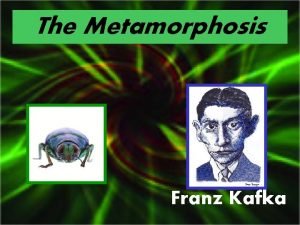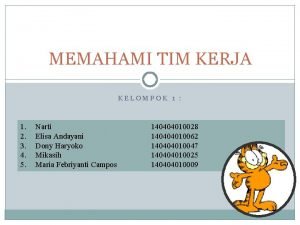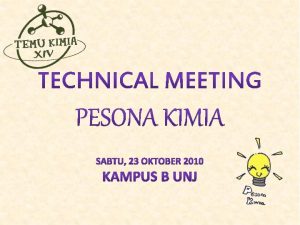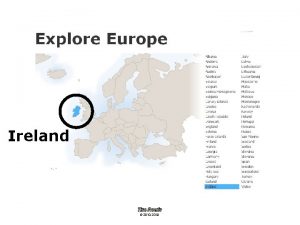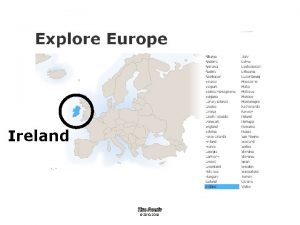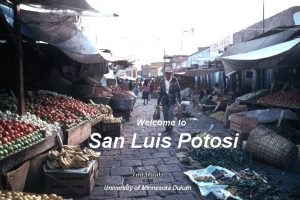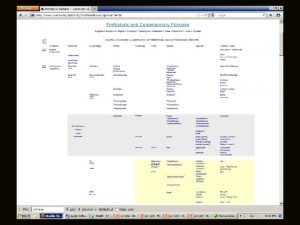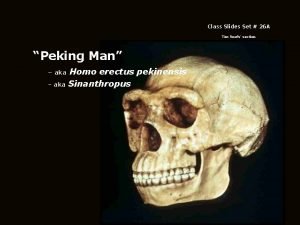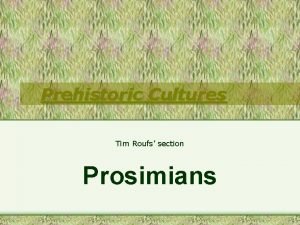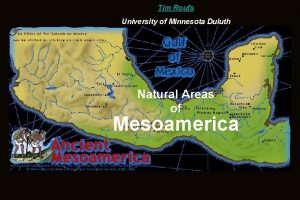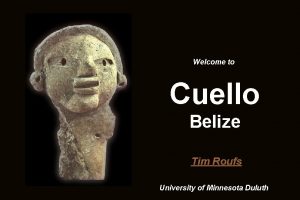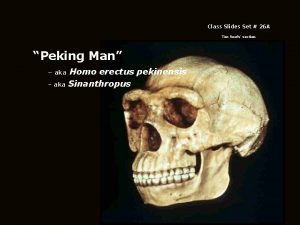Tim Roufs 2010 2019 www d umn educlafacultytroufsanthfoodaftexts

















































































































- Slides: 113

Tim Roufs © 2010 -2019 www. d. umn. edu/cla/faculty/troufs/anthfood/aftexts. html#title

use your up/down arrow keys and/or your space bar to advance the slides Diet and Evolution: Paleontology Tim Roufs © 2010 -2019 www. d. umn. edu/cla/faculty/troufs/anthfood/aftexts. html#title

Diet and Evolution: Paleontology Tim Roufs © 2010 -2019 www. d. umn. edu/cla/faculty/troufs/anthfood/aftexts. html#title

Diet and Human Evolution • Exploring the Diets of Extinct Humans Through Paleontology • • • Teeth • Skulls and Jaws • The Postcranial Skeleton What Is Adaptation? Using Chemistry to Infer the Diets of Extinct Hominids Our Place in Nature A Brief Who's Who of the Early Hominids What Did Early Hominids Eat? What Can We Say About the Diets of Fossil Homo? Summary Highlight: Lactose Intolerance

Diet and Human Evolution • Exploring the Diets of Extinct Humans Through Paleontology • • • Teeth • Skulls and Jaws • The Postcranial Skeleton What Is Adaptation? Using Chemistry to Infer the Diets study fossilized remains of Extinct Hominids Our Place inof Nature extinct animals and plants A Brief Who's Who of the Early Hominids What Did Early Hominids Eat? specialize in the study of What Can We Say About the Diets of Fossil Homo? Summary fossilized remains of plants Highlight: Lactose Intolerance paleontologists paleobotanists

you’ve seen paleontology on the chart earlier. . .

Diet and Human Evolution • Exploring the Diets of Extinct Humans Through Paleontology • • • Teeth • Skulls and Jaws • The Postcranial Skeleton What Is Adaptation? Using Chemistry to Infer the Diets of Extinct Hominids Our Place in Nature A Brief Who's Who of the Early Hominids What Did Early Hominids Eat? What Can We Say About the Diets of Fossil Homo? Summary Highlight: Lactose Intolerance

hominids “We are what they ate. ” The Cultural Feast, 2 nd ed. , p. 17

now “hominins” / hominini hominids “We are what they ate. ” The Cultural Feast, 2 nd ed. , p. 17

Diet and Human Evolution • Exploring the Diets of Extinct Humans Through Paleontology • Teeth • Exploring the Diets of Extinct Humans • Skulls and Jaws • The Postcranial Skeleton Through Paleontology • What Is Adaptation? • Using Chemistry to Infer the Diets of Extinct Hominids • Our Place in Nature • A Brief Who's Who of the Early Hominids • What Did Early Hominids Eat? • What Can We Say About the Diets of Fossil Homo? • Summary • Highlight: Lactose Intolerance

Diet and Human Evolution • Exploring the Diets of Extinct Humans Through Paleontology • Teeth • Exploring the Diets of Extinct Humans • Skulls and Jaws • The Postcranial Skeleton Through Paleontology • What Is Adaptation? • Using Chemistry to Infer the Diets of Extinct Hominids • Our Place in Nature • A Brief Who's Who of the Early Hominids • What Did Early Hominids Eat? • What Can We Say About the Diets of Fossil Homo? • primates • Summary • prosimians • Highlight: Lactose Intolerance • paleontology • paleobotanists • paleontologists

REM paleontologists study fossilized remains of extinct animals and plants paleobotanists specialize in the study of fossilized remains of plants

Diet and Human Evolution • Exploring the Diets of Extinct Humans Through Paleontology • Teeth • Exploring the Diets of Extinct Humans • Skulls and Jaws • The Postcranial Skeleton Through Paleontology • What Is Adaptation? • paleontology • Using Chemistry to Infer the Diets of Extinct Hominini • paleobotanists • Our Place in Nature • paleontologists • A Brief Who's Who of the Early Hominini • What Did Early Hominini Eat? • primates • What Can We Say About the Diets of Fossil Homo? • prosimians (“pre-monkeys”) • Summary • Highlight: Lactose Intolerance

“Primates” a biological “Order” comprised of prosimians (“pre-monkeys”) monkeys apes humans

pre-monkeys prosimians monkeys apes humans

“Hominoids” = all living and extinct apes and humans aka Hominoidea The Cultural Feast, 2 nd ed. , p. 20

prosimians Hominoids monkeys apes humans

Hominoids gibbons humans bonobos orangutans chimps gorillas Campbell and Loy, Humankind Emerging, 8 th ed. , p. 138 ff.

“Hominini” = modern humans and their nearest predecessors aka Hominidae The Cultural Feast, 2 nd ed. , p. 20.

TRADITIONAL CLASSIFICATION

pre-monkeys prosimians

prosimians monkeys

prosimians monkeys apes

prosimians monkeys apes bipedal apes

prosimians monkeys apes bipedal apes humans

prosimians monkeys and these were apes “hominids” (until 1980) bipedal apes humans

TRADITIONAL prosimians CLASSIFICATION monkeys and these were apes “hominids” (until 1980) bipedal apes humans

pre-monkeys prosimians monkeys apes humans

Cf. , Understanding Humans: Introduction to Physical Anthropology and Archaeology, 11 th ed. Barry Lewis, Robert Jurmain, and Lynn Kilgore Belmont, CA: Wadsworth Publishing © 2012

NEW CLASSIFICATION “Hominini” = “colloquial term for members of the “tribe” Hominini, the evolutionary group that includes modern human and now-extinct bipedal relatives”

TRADITIONAL prosimians CLASSIFICATION monkeys these were apes “hominids” (until 1980) bipedal apes humans

NEW prosimians CLASSIFICATION monkeys now these are Hominins ”hominins” apes bipedal apes humans

NEW prosimians CLASSIFICATION monkeys the bipeds are in one “tribe” (ape AND human) now these are Hominins ”hominins” apes bipedal apes humans

meet “Lucy”, the most famous of the prehistoric hominini. . .

for e. g. , Lucy and “The First Family” Understanding Physical Anthropology and Archaeology, 9 th ed. , p. 206

for e. g. , Lucy and “The First Family” Understanding Physical Anthropology and Archaeology, 9 th ed. , p. 206

“Lucy" and "The First Family" • from: Hadar, Ethiopia (“Site 333” on the Awash River) • aka: Australopithecus • age: 3. 9 – 2. 9 mya • discovered: 1975 -1976 afarensis

we’ll meet more hominini later. . . first, some of their characteristics. . .

Diet and Human Evolution • Exploring the Diets of Extinct Humans Through Paleontology • Teeth • Exploring the Diets of Extinct Humans • Skulls and Jaws • The Postcranial Skeleton Through Paleontology • What Is Adaptation? • Using Chemistry to Infer the Diets • Teeth of Extinct Hominini Skulls and Jaws • Our • Place in Nature • A Brief Who's Who of the Early. Skeleton Hominini • The Postcranial • What Did Early Hominini Eat? • What Can We Say About the Diets of Fossil Homo? • Summary • Highlight: Lactose Intolerance

Diet and Human Evolution • Exploring the Diets of Extinct Humans Through Paleontology • Teeth • Exploring the Diets of Extinct Humans • Skulls and Jaws • The Postcranial Skeleton Through Paleontology • What Is Adaptation? • Using Chemistry to Infer the Diets of Extinct Hominini • Our • Place in Nature Skulls and Jaws • A Brief Who's Who of the Early Hominini • The Postcranial • What Did Early Hominini Eat? Skeleton • What Can We Say About the Diets of Fossil Homo? • Summary • Highlight: Lactose Intolerance • Teeth

Diet and Human Evolution • Exploring the Diets of Extinct Humans Through Paleontology • Teeth • Exploring the Diets of Extinct • Skulls and Jaws • The Postcranial Skeleton Through Paleontology • What Is Adaptation? • Using Chemistry to Infer the Diets of Extinct Hominini • Our Place in Nature • A Brief Who's Who of the Early Hominini • Highlight: Lactose Intolerance Humans • Teeth are obviously related to food and food gathering

www. newswise. com/articles/view/549004/? sc=rssn

useful markers of the earliest hominids / hominini: • adaptations for bipedalism … • reduced canine length … and this is though mostly to relate to a change in diet

apes (and monkeys) still possess conical, daggerish canines which project well beyond the surface of the opposite teeth. . .

apes (and monkeys) still possess conical, daggerish canines which project well beyond the surface of the opposite teeth. . . so they can’t easily grind sideways with their peaked molar teeth. . .

their canines lock, and they cannot easily grind sideways with their peaked molars. . . Teeth of a male patas monkey Understanding Physical Anthropology and Archaeology, 9 th ed. , p. 205

because of the overlap they have diastema. . .

diastema = a space in the tooth row that accommodates one or more teeth from the opposite jaw

Teeth of a male patas monkey Understanding Physical Anthropology and Archaeology, 9 th ed. , p. 205

diastema Teeth of a male patas monkey Understanding Physical Anthropology and Archaeology, 9 th ed. , p. 205

diastema

these big canine teeth are reduced in the hominids / hominini. . . and this is though mostly to relate to a change in diet

there also some related changes in the skull and jaw. . . you can see these by comparing the skull and jaw of a modern human to those of a gorilla. . .

there also some related changes in the skull and jaw. . . you can see these by comparing the skull and jaw of a modern human to those of a gorilla. . .

Diet and Human Evolution • Exploring the Diets of Extinct Humans Through Paleontology • Teeth • Exploring • Skulls and the Jaws Diets of Extinct Humans • The Postcranial Skeleton Through Paleontology • What Is Adaptation? • Teeth • Using Chemistry to Infer the Diets of Extinct Hominini • Our Place in Nature • The Postcranial Skeleton • A Brief Who's Who of the Early Hominini • What Did Early Hominini Eat? • What Can We Say About the Diets of Fossil Homo? • Summary • Highlight: Lactose Intolerance • Skulls and Jaws

Diet and Human Evolution • Exploring the Diets of Extinct Humans Through Paleontology • Teeth • Exploring • Skulls and the Jaws Diets of Extinct Humans • The Postcranial Skeleton Through Paleontology • What Is Adaptation? • Teeth • Using Chemistry to Infer the Diets of Extinct Hominini • Our Place in Nature • A Brief Who's Who of the Early Hominini • The Postcranial Skeleton • What Did Early Hominini Eat? • What Can We Say About the Diets of Fossil Homo? • Summary • Highlight: Lactose Intolerance cranium • Skull =and Jaws

Modern human cranium Understanding Physical Anthropology and Archaeology, 9 th ed. , p. 432

the lower jaw = mandible see also the related “mandibular torus”

Modern mandible on a human cranium Understanding Physical Anthropology and Archaeology, 9 th ed. , p. 432

in apes mandibles slant outward and downward, without a chin (“prognathism”)

Diet and Human Evolution • Exploring the Diets of Extinct Humans Through Paleontology • Teeth • Exploring the Diets of Extinct Humans • Skulls and Jaws • The Postcranial Skeleton Through Paleontology • What Is Adaptation? • Using Chemistry to Infer the Diets • Teeth of Extinct Hominini • Our Place in Nature • A Brief Who's Who of the Early Hominini • What Did Early Hominini Eat? • What Can We Say About the Diets of Fossil Homo? • The Postcranial Skeleton • Summary • Highlight: Lactose Intolerance • Skulls and Jaws • Saggital crest

apes have a ridge running down the top of their skulls that’s called a saggital crest. . . that is where the jaw muscles attach. . . and that feature is related to powerful chewing. . .

saggital crest Western Lowland Gorilla (male) source

apes and have a ridge running down the top of their skulls that’s called a saggital crest. . . that is where the jaw muscles attach. . . and that feature is related to powerful chewing. . .

Pongid Prognathism (Line of greatest muscle force is shown in red) Understanding Physical Anthropology and Archaeology, 8 th ed. , p. 245

apes and have a ridge running down the top of their skulls that’s called a saggital crest. . . that is where the jaw muscles attach. . . and that feature is related to powerful chewing. . .

Satittal crests and temporal muscle orientations Hominid compared to pongid (Line of greatest muscle force is shown in red) Understanding Physical Anthropology and Archaeology, 8 th ed. , p. 245

apes have a “simian shelf” rather than a chin. . . in humans lower jaw is comparatively small, but always has a distinct chin. . .

Note: no chin Pongid Prognathism (Line of greatest muscle force is shown in red) Understanding Physical Anthropology and Archaeology, 8 th ed. , p. 245

apes have a “simian shelf” rather than a chin. . . in humans the lower jaw is comparatively small, but they always have a distinct chin. . .

distinct chin Modern human cranium Understanding Physical Anthropology and Archaeology, 9 th ed. , p. 432

source

useful markers of the earliest hominines: • adaptations for bipedalism. . . • reduced canine length (teeth). . . and these relate to food. . .

Diet and Human Evolution • Exploring the Diets of Extinct Humans Through Paleontology • Teeth • Exploring the Diets of Extinct Humans • Skulls and Jaws • The Postcranial Skeleton Through Paleontology • What Is Adaptation? • Using Chemistry to Infer the Diets • Teeth of Extinct Hominini Skulls and Jaws • Our • Place in Nature • A Brief Who's Who of the Early Hominini • What Did Early Hominini Eat? • What Can We Say About the Diets of Fossil Homo? • Summary • Highlight: Lactose Intolerance • The Postcranial Skeleton

postcranial = below the head (with bipeds) behind the head (with quadrupeds)

Postcrania modern human New World monkey Understanding Physical Anthropology and Archaeology, 8 th ed. , pp. 223, 128

Homo sapiens NOTE: 165, 000 ybp-present 500, 000 -28, 000 ybp anything called 1. 8 mya– 25, 000 ybp Moderns (Cro-magnon …) Premoderns (Neandertal …) Homo erectus -pithecus 2. 4 -1. 6 mya Homo habilis Paranthropus is an ape 2. 5 -1 mya 4. 25 -2 mya Australopithecus e. g. , Sivapithecus 15 -7 mya dates are approximate and follow Understanding Humans 2009

Homo sapiens Moderns (Cro-magnon …) Premoderns (Neandertal …) Homo erectus Homo habilis Paranthropus Australopithecus Sivapithecus 165, 000 ybp-present 500, 000 -28, 000 ybp 1. 8 mya– 25, 000 ybp 2. 4 -1. 6 mya 2. 5 -1 mya 4. 25 -2 mya 15 -7 mya dates are approximate and follow Understanding Humans 2009

Homo sapiens Moderns (Cro-magnon …) Premoderns (Neandertal …) 165, 000 ybp-present 500, 000 -28, 000 ybp mya– 25, 000 ybp Homo erectus 1. 8 apes modern-day are 2. 4 -1. 6 mya Homo habilis not bipeds 2. 5 -1 mya Paranthropus they’re brachiators 4. 25 -2 mya Australopithecus as were the prehistoric –pithecines, like. . . Sivapithecus 15 -7 mya dates are approximate and follow Understanding Humans 2009

The first “real” ape Sivapithecus 15 -7 mya Time 23 July 2001

Sivapithecines

note activities. . . Sivapithecines

Bipedal Locomotion Sivapithecus was not a biped. . .

Bipedal Locomotion Why did bipedalism develop? there a lot of theories … several of them related to food procurement and use …

Bipedal Locomotion Why bipedalism? there a lot of theories. . . and several of them relate to food procurement and use. . .

Bipedal Locomotion Why bipedalism? Owen Lovejoy for example, thinks it’s ALL about food. . . “provisioning hypothesis”

Bipedal Locomotion Why bipedalism? Owen Lovejoy for example, thinks it’s ALL about food. . . and that’s his “provisioning hypothesis”

Lovejoy’s ideas on bipedalism specifically relate to male help in carrying food back to the “home base”. . . a feature known as “provisioning”

Lovejoy’s ideas on bipedalism specifically relate to male help in carrying food back to the “home base”. . . a feature known as “provisioning”

. . . male help in “provisioning” this is Owen Lovejoy’s “provisioning hypothesis”

Possible Factors Influencing the Initial Evolution of Bipedal Locomotion in Hominini Understanding Physical Anthropology and Archaeology, 8 th ed. , p. 217

Possible Factors Influencing the Initial Evolution of Bipedal Locomotion in Hominini Understanding Physical Anthropology and Archaeology, 8 th ed. , p. 217

Owen Lovejoy notes that bipedalism relates to long-distance walking. . . including carrying food while provisioning

Possible Factors Influencing the Initial Evolution of Bipedal Locomotion in Hominini Understanding Physical Anthropology and Archaeology, 8 th ed. , p. 217

. . . and even non-bipeds carry food. . .

Chimpanzee The Primates, Time-Life (1974) p. 71

Possible Factors Influencing the Initial Evolution of Bipedal Locomotion in Hominini Understanding Physical Anthropology and Archaeology, 8 th ed. , p. 217

and bipedalism and vision (visual surveillance) are related to the quest for food. . .

Eye-Height advantage of Bipedal Locomotion in Hunting. . .

Eye-Height advantage of Bipedal Locomotion in Hunting. . .

Eye Level and Sight. Humankind Emerging, 7 th ed. , p. 114

bipedalism is related to seed and nut gathering and feeding from bushes. . .

Possible Factors Influencing the Initial Evolution of Bipedal Locomotion in Hominini Understanding Physical Anthropology and Archaeology, 8 th ed. , p. 217


The Emergence of Humankind 4 th Ed. , p. 105

bipedalism is also related to tool use. . . including such simple tools as a digging stick. . . (aka a “dibble” or “coa”)

bipedalism is also related to hunting. . .

Possible Factors Influencing the Initial Evolution of Bipedal Locomotion in Hominini Understanding Physical Anthropology and Archaeology, 8 th ed. , p. 217

Hunting / Gathering / Collecting (foraging)

Possible Factors Influencing the Initial Evolution of Bipedal Locomotion in Hominini Understanding Physical Anthropology and Archaeology, 8 th ed. , p. 217

much of this is summarized in. . . New York University Press 2005

Diet and Evolution: Paleontology Reviewed Tim Roufs © 2010 -2019 www. d. umn. edu/cla/faculty/troufs/anthfood/aftexts. html#title

Tim Roufs © 2010 -2019 www. d. umn. edu/cla/faculty/troufs/anthfood/aftexts. html#title
 Tim roufs
Tim roufs Tim roufs
Tim roufs Umn jst
Umn jst Umn marketplace
Umn marketplace Psedobulbar
Psedobulbar Jst umn
Jst umn Umarket umn
Umarket umn Whats msds
Whats msds Umn jst
Umn jst Umn dehs
Umn dehs Art a reporting tool
Art a reporting tool Umn majors
Umn majors Jst umn
Jst umn Umn vs lmn
Umn vs lmn Umn jst
Umn jst Perbedaan lesi umn dan lmn
Perbedaan lesi umn dan lmn Roger rusack
Roger rusack Shibps
Shibps Umn jst
Umn jst Chemistry stockroom umn
Chemistry stockroom umn Umn controller's office
Umn controller's office Jst umn
Jst umn Lib umn
Lib umn Winkel 2005
Winkel 2005 Jst umn
Jst umn Umn vs lmn
Umn vs lmn Umn external sales
Umn external sales Payroll umn
Payroll umn Srt.umn/blue
Srt.umn/blue Umn canvs
Umn canvs Ergonomics
Ergonomics Jst umn
Jst umn The arrow umn
The arrow umn Umn faculty dental clinic
Umn faculty dental clinic Csci 1933 umn
Csci 1933 umn Aplus umn
Aplus umn Umarket umn
Umarket umn Mnc umn
Mnc umn Umn wellbeing
Umn wellbeing Umn jst
Umn jst What is characterization?
What is characterization? Jst umn
Jst umn Neil anderson umn
Neil anderson umn Umn ilab
Umn ilab Jst umn
Jst umn Aplus umn
Aplus umn Jst umn
Jst umn Umn civil engineering
Umn civil engineering Timothy burrows
Timothy burrows Tim holliday
Tim holliday Tim bell cern
Tim bell cern Tìm việc làm
Tìm việc làm Pvt tim hall
Pvt tim hall Tim too many young people are
Tim too many young people are Tim i timski rad
Tim i timski rad Tim hudson cryptsoft
Tim hudson cryptsoft Stephen ruttle qc
Stephen ruttle qc Tim peake ks1
Tim peake ks1 Tim engels
Tim engels Tim whipple utah
Tim whipple utah Tim za kvalitetu
Tim za kvalitetu Tim bullivant
Tim bullivant Martijn van iersel
Martijn van iersel 1 timothy 4 12
1 timothy 4 12 Tim stepp
Tim stepp Herwegh aufruf
Herwegh aufruf Autism background
Autism background Lamanya pelaksanaan rapid health assessment
Lamanya pelaksanaan rapid health assessment Bài tập về nhà
Bài tập về nhà Plp mechanism transamination
Plp mechanism transamination Tim roehl
Tim roehl Kelompok terdiri dari
Kelompok terdiri dari Tim app inventor
Tim app inventor Lulusan ti mana tim berners teh
Lulusan ti mana tim berners teh Tim goldmann
Tim goldmann Tim sheard
Tim sheard Tim skerry
Tim skerry Tim alba
Tim alba Tim roth ernie roth
Tim roth ernie roth Tim kenefick
Tim kenefick 1 timoteo 3 16
1 timoteo 3 16 Phần tử tối đại
Phần tử tối đại Tim cassidy
Tim cassidy Tim philbrick
Tim philbrick Sonynetworkentertainment. com
Sonynetworkentertainment. com Mbg 453
Mbg 453 Khai triển taylor hàm 2 biến
Khai triển taylor hàm 2 biến Lệnh tìm kiếm đơn giản trong access
Lệnh tìm kiếm đơn giản trong access Tim berndtsson
Tim berndtsson Tim obrian
Tim obrian Tim berndtsson
Tim berndtsson Tim burton analysis essay
Tim burton analysis essay Contoh kelompok kerja dan tim kerja
Contoh kelompok kerja dan tim kerja Tim toohig
Tim toohig Tim moriau training
Tim moriau training Tim kostamo
Tim kostamo Ahspo
Ahspo Tim neutron
Tim neutron Mô cơ tim cắt ngang
Mô cơ tim cắt ngang Tim de ceunynck
Tim de ceunynck Tim roth metamorphosis
Tim roth metamorphosis Tim burton essay
Tim burton essay Memahami tim kerja
Memahami tim kerja Timothy meyer vanderbilt
Timothy meyer vanderbilt Tim petry
Tim petry Tim apel
Tim apel Tim pennock
Tim pennock Tim beners
Tim beners Suatu tim lomba pesona kimia
Suatu tim lomba pesona kimia Ce tim
Ce tim 吳文琛
吳文琛 Tim lsbh
Tim lsbh 1 timothy 5:17 nkjv
1 timothy 5:17 nkjv Tim bralower
Tim bralower









